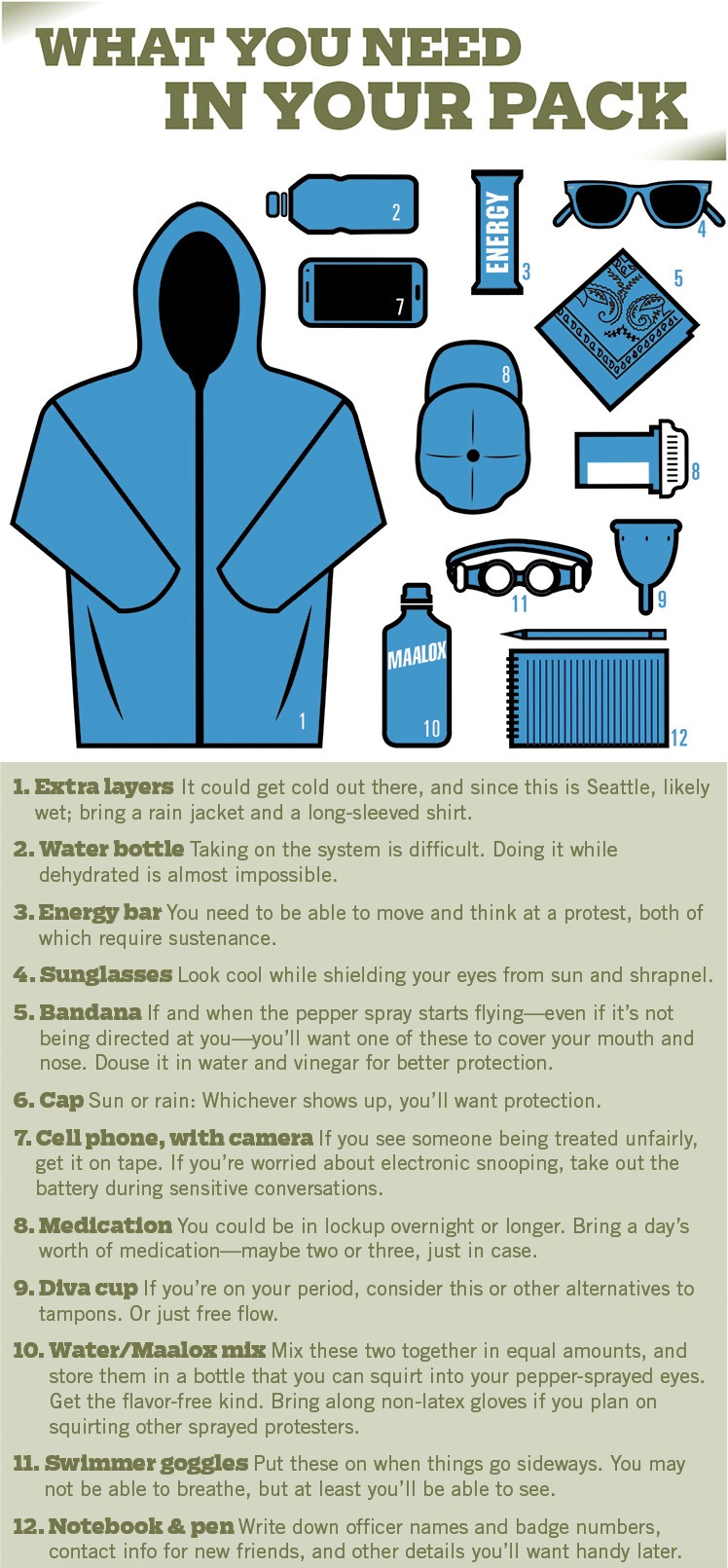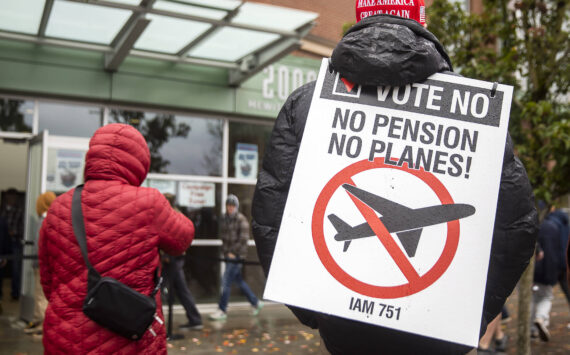Protesting is harder than it looks.
From the vantage point of a passerby or TV-news consumer, walking around in a crowd with a sign for a couple hours is a piece of cake. But let’s face it: Asking nicely for change doesn’t always work. To be effective, protesters must sometimes force a crisis—that is, interrupt some vital piece of social machinery like a highway or place of business, so that leaders are unable to ignore their demands. The squeaky wheel gets the grease, as the saying goes. Recent Seattle protest have included sit-ins and blocked intersections, as well as some targeted property destruction by radicals and some not-particularly-targeted pepper spray from police.
So if street protest is a way of renegotiating the social contract—the basic, shared norms of behavior that are the difference between a random collection of people and a society—how, exactly, do you do it? Seattle Weekly’s got your back. Based on our reporters’ experiences covering protests and interviews with veteran activists, here are ten tips for anyone stepping onto the street with a heart the size of a fist, ready to love and fight.
1. Buddy Up
Street protests aren’t necessarily dangerous, but they certainly can be. Just ask Sam Levine, an independent journalist who was filming the conflict between police and the black bloc on May Day last year when shrapnel from a crowd-control grenade, launched by an officer of the Seattle Police Department, tore a penny-sized hole in his left cheek. “Is my face gone?” he asked the strangers who surrounded him. It wasn’t, but it was permanently altered; nine months later, his left cheek slumps a bit, as though he’d had a stroke.
Instead of a buddy, Levine had luck: the luck to remain conscious and be surrounded by level-headed observers, who helped him until an officer allowed Levine to walk to an ambulance behind police lines.
Don’t count on luck. In case your face gets punctured by police shrapnel or doused in pepper spray, or you find yourself panicking and unable to think clearly, have help at hand. Protest with a buddy. Watch each other’s backs. Be ready to ride to the hospital with your buddy or procure medicine and/or bail money if they end up in jail. (Bail in Washington is typically $500 for misdemeanors and $1,000 for gross misdemeanors, but arrested protesters who live in the area are usually released on their own recognizance once they see a judge.)
Also be ready to share water and snacks, strategize about what kind of action you want to take, and debrief afterwards. Practice rinsing one another’s eyes for pepper spray beforehand. Be ready, together.
2. Have a Plan
“In preparing for battle,” Ike Eisenhower once said, “I have always found that plans are useless, but planning is indispensable.”
These are words to live by. Go into protests with at least a rough idea of where you’re going and what you’re going to do there. Follow activists and journalists on Twitter to stay apprised of upcoming protest events, and contact protest organizers through social media if you have specific questions for them, like: When and where? What transportation is available? How confrontational will the march be? Is there a leadership structure? Have contingencies in mind in case something goes wrong, including one or more rendezvous points and times arranged with your buddy in case your cell phone dies. Talk with your buddy about how much tolerance for risk you each have. If one of you does get arrested or hospitalized, there should be a plan to help care for children, pets, or plants.
Maybe you want to plan your own protest.Thanks to the First Amendment, you do not need a permit to do so, but police can intervene and arrest if you block traffic or damage property. If you want to coordinate with the city and have police clear a route for your march, you can apply for a permit through the Special Events Office.
3. Be Prepared
Do you have water? Medication? A half-and-half mix of water and alcohol-free Maalox? This last item is for rinsing pepper spray (oleoresin capsicum, or “OC”) from your eyes and other mucous membranes. Hopefully you won’t need it, but maybe you will. See our checklist below this story for more stuff you will want to bring—but also remember that every item adds to the weight you’ll have to carry during the march. So pack light, as you would for a hike across the city, because that’s exactly what often happens in protests, except with cops in Darth Vader gear spraying hot sauce into your eyes, sometimes. Also, there is usually nowhere to poop.
If you’re on your period, consider a reusable “Diva Cup” instead of a tampon in case you get arrested and are unable to change menstrual products for a while (and also so that OC doesn’t wick its way up a tampon into your mucous membranes—ouch!). Wear eyeglasses instead of contacts, strap on some good walking shoes, and dress in layers of weather-appropriate clothing. Write the following phone number in permanent marker on your upper arm so that it doesn’t get wiped off in the process of arrest: 206-422-4663. It’s a demonstration support line run by the National Lawyer’s Guild that is staffed by attorneys and tracks arrestees and witnesses.
4. Deploy Strategically
Some claim that simply venting rage at injustice is a good-enough reason to take to the streets. There’s certainly something to be said for collectively expressing shared emotion, but on the other hand there’s a lot to be said for not screwing up traffic just because you feel like it.
In any event, this guide is addressed to protesters with an agenda—that is, specific goals and a plan for effecting them. So what is your agenda? How will your actions advance it? In 1999, protesters interrupted a World Trade Organization summit in Seattle by strategically blocking traffic. Yet not all strategies need be so overtly tactical. Plenty of successful protests have had a simple strategy of presence, showing solidarity with an arrested peer so the detained resister doesn’t think she or he is forgotten.
Remember to identify and appeal to a specific audience. In contrast to sabotage or private correspondence, protest is by definition a kind of political theater. It addresses someone about something. Often that someone is an elected leader or a private-business boss, but protest can also address the public at large or members of a particular group. For example, Black Lives Matter marchers have sometimes snubbed the media—not because they don’t understand how publicity works, but because mainstream America isn’t necessarily their target audience. Peers on social media are, according to several local BLM activists. May Day anti-capitalist marchers often damage, or try to damage, property in an overtly symbolic way—for instance, smashing a window on a building owned and operated by a corporation that has relied on child sweatshop labor. This kind of property damage is less of a threat to the one percent and more of a rallying cry—“Smash capitalism!”—to the 99 percent.
While protests, civil disobedience, and other conflicts with authorities always make a statement, that doesn’t have to be their main purpose. These situations can also teach people how to rebel together and how to live together. For example, Occupy Wall Street is memorable in part for its experiments in non-capitalist living, and ongoing organizing for Black Lives Matter has engendered a new generation of political leaders in the struggle for social justice. This kind of learning is strategically valuable in its own right. A word to the wise, though: Be conscious about what you’re learning, what kind of culture of resistance you’re building. Is it just? Is it effective? Is it sustainable? Does it value life and consent? Is it kind? As you fight the status quo, what new reality are you creating?
5. Do No (Unnecessary) Harm
When you protest, you are, among other things, acknowledging the moral fact that humans are responsible for one another. Otherwise there would be no point to your protest. You cannot effectively object to injustice without tacitly endorsing justice.
Your responsibilities as a protester don’t extend only to causes like black lives or the environment; they also extend to the individuals around you, including fellow protesters, passersby, and cops. Exactly what those responsibilities are is open to debate. Respecting a police officer’s humanity doesn’t imply submission or deference. Resist as you see fit. But don’t forget that beneath that riot gear is a human being, warts and all.
[Note to Seattle’s Finest: You might want to keep the same thing in mind the next time you reach for the pepper spray.]
6. Protect Your Tech
In 2008 the Tacoma Police Department secretly bought a “Stingray” device that physically tracks people via their cell phones by pretending to be a cell-phone tower, according to the Tacoma News Tribune. Here in Seattle, police pay for a web service that monitors activists’ social-media accounts. As whistleblower Edward Snowden revealed, the National Security Agency is collecting all the telephone data it can get its hands on. It also has the ability not only to tap your cell phone, but also to turn it on remotely.
If you’re effective at changing the status quo, there’s a fair chance the minders of the status quo will take an interest in you. The simplest way to prevent the kind of snooping described above is restraint: Take the battery out of your smartphone, or leave it at home, if you don’t want to be tracked, and remember that someone may be watching when you post on social-media platforms like Twitter. Of course, these precautions can make it more difficult to communicate clearly with other activists, which can reduce your effectiveness. The trade-off between security and efficacy is one you’ll have to manage for yourself.
Another tool you can use to protect your privacy is encryption—in other words, turning your messages into code that can be deciphered only by someone with the right key. For text messages, you can use Signal, which automatically encrypts messages sent to other Signal users (but is still able to send and receive normal text messages with those not on Signal). For e-mail, you can use a tool called Pretty Good Privacy, which comes in a bunch of free services including the Gmail add-on CryptUP. If you want to hide your web browsing from voyeurs, consider Tor, a browser that routes your Internet traffic through a global relay system to anonymize it.
Two warnings. First, no security is perfect, so don’t expect it to be. You can make it harder to get snooped, but not impossible. Second, the very act of taking e-security measures is itself a red flag to government watchers. For instance, documents released by Snowden and others have shown that the NSA automatically tracks people who even just read about Tor online.
7. Beware of Moles
“John Jacob” was a well-known radical activist in Olympia for years, until Evergreen State College student Brendan Maslauskas Dunn and police accountability activist Drew Hendricks got suspicious. After discovering through a public-records request that they and other radical activists in Olympia were being surveilled by several police agencies and the military, the pair gradually suspected, then confirmed, that the man they knew as John Jacob was actually John Towery, a civilian employee of the Army who was passing information to the military and local police agencies. Towery’s leaked information appears to have led to the false arrests of several activists who’d been working to stop military equipment from being shipped through regional ports.
“They gathered [the evidence against Towery] piece by piece,” says Larry Hildes, the attorney who represents Dunn and other activists in a lawsuit against Towery and the government. “They very systematically checked out who he was … and very methodically and quietly gathered the evidence until they had incontrovertible proof.” It later came out that Towery tried to persuade at least one antiwar activist to buy guns.
Hildes’ advice for activists worried about similar infiltration? “Don’t get paranoid,” he says. “Be careful what you say and who you say it to, but don’t let the threat of surveillance prevent you from organizing and speaking out. If you have suspicions about someone, don’t start announcing them. Talk to someone you trust and sort of feel them out little by little.
“The easiest way to destroy a group is to have everyone calling each other an infiltrator,” Hildes adds. “If you have real proof, then do something about it. But assume that there are people attending meetings that are not friendly; assume you may have an infiltrator.”
It’s hard to say how common Towery’s kind of spying is, but it’s not unheard of. In 2003, members of the group Peace Fresno learned they’d been infiltrated by an undercover detective. From 2004 to 2006, the FBI paid an informant named “Anna” to entrap eco activists into bombing “the Nimbus Dam in California, cellphone towers, science labs, and other targets,” according to The Guardian’s Ed Pilkington.
“This surveillance is no error,” writes journalist Will Potter in Green Is the New Red, his book on how the federal government uses terrorism legislation to target environmental and animal-rights activists. “It is systemic.” Bottom line: the government spies on and infiltrates activist groups, and sometimes tries to goad activists into committing felonies. This is a real thing. It actually happens. That’s why, Hildes says, it’s essential to know when to say no. “If someone starts pushing you to take action that doesn’t make sense,” he says, “don’t do it.”
8. Don’t Panic
Jorge Torres didn’t expect to spend a night in jail in December 2014. But after police arrested him at a street protest for pedestrian interference and reckless endangerment, that’s exactly what happened.
According to Torres, whose charges were later dismissed with prejudice, guards at the county jail went out of their way to try and scare him about a night in the clink, saying things like, “This is your first time here, isn’t it? You don’t know what you’re getting into. Don’t get beat up here tonight!”
“My stay overnight there with about 19 other prisoners was just fine,” Torres told us afterwards. “Everybody there was very polite to me. It’s amazing how far giving your food away can go.”
The lesson to take from this: whatever happens, don’t panic. As Portland’s Rosehip Medic Collective (which among other things provides emergency healthcare to injured protesters) puts it in one of its training manuals, “The number-one weapon of the police is fear.” Your number-one defense against that weapon is calm. If you are arrested, do not resist, but also don’t volunteer any information. A partial caveat to this rule: “If the officer believes the person is committing a criminal act and asks for name and address with the intention of citing the person,” says Doug Honig, spokesperson for the state ACLU, “refusing to provide that name and address can be grounds for arresting the person because failure to provide that info makes it impossible for the officer to write a citation.”
Other than possibly giving your name and address, do not talk to police without a lawyer. Ascertain that you’re actually under arrest, ask why you’re under arrest, note the officer’s name and badge number, and say “I wish to remain silent and I want to talk to a lawyer” over and over again, as many times as you need to. Remember that you are Constitutionally entitled to an attorney, regardless of your ability to pay. All this is doubly important if you are an undocumented immigrant or have other legal troubles hanging over your head. Seattle employees, including police, are typically barred from asking people about their immigration status, but there are exceptions.
9. Debrief
As soon as possible following any protest, document any injuries, even if they seem like they’re not a big deal. Take well-lit photographs with a coin or some other object to indicate the size of the injury. This isn’t just about you: Publicly documenting physical harm caused by police or others makes it harder for them to justify that harm next time around. Remember: pics, or it didn’t happen.
Whether you post those pics on social media is up to you. On the one hand, a picture of a blastball bruise is worth more than a thousand-word essay on police brutality. On the other hand, you may want to keep those photos to yourself at first if you plan to use them in a lawsuit or complaint.
Debrief with someone you trust and who ideally was also present at the protest. Most protests are fairly boring. But protests can be traumatic, filled with explosions, pepper spray, and rage, and talking through your feelings can be healing. Some symptoms of trauma to watch for include feeling numb or disconnected from your body, staring into space, and feelings of hopelessness or desperation. Take time to care for yourself, alone or with friends and family. Sleep and exercise. Journal.
If you’re contaminated with OC, drink lots of water to clear it from your system. Put your contaminated clothes in a plastic bag to be cleaned separately from other laundry. Shower in cool water to clear OC from your body without opening the pores of your skin to chemical attack.
10. Keep Pushing
“Being an activist is not about promoting absolute solutions, which stirs passions while obstructing logic,” writes former Seattle City Councilmember Nick Licata in his book Becoming a Citizen Activist. “It’s about addressing people’s anger by giving them some control over their lives.” Taking to the streets is certainly one way to address anger and seize control, but it’s temporary. By itself, street protest accomplishes little more than yelling. Lasting change requires the boring work of building alternatives.
One way to build such alternatives is disciplined lobbying of elected officials, who, thanks to a kind of natural selection, tend to care about getting re-elected more than about any particular issue. With a handful of fellow constituents, politely but inexorably hound officials (your officials—they don’t care what you think if you’re not voting in their re-election) with specific, factual questions and requests at town halls, photo ops, public meetings, and their offices. Make it easy for them to say “Yes” and hard to say “No.”
Another approach is simply to bypass the authorities by finding a problem and fixing it yourself. That’s how we in the Seattle area got homeless encampments and clean-needle exchanges: A couple of local activists got tired of watching their friends die from exposure and AIDS, respectively, so they found the best solutions available and made them happen, saving countless lives in the process.
There’s a saying among anarchists that bears repeating at the beginning of this new chapter in American history: diversity of tactics. No one approach will protect our neighbors and safeguard our future. But our collective power as citizens to claim the streets is a tool that should not go wasted.
Knowing Seattle, it probably won’t be.
cjaywork@seattleweekly.com
This post has been edited to correctly spell the name of Brendan Maslauskas Dunn.









